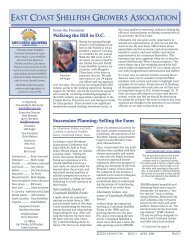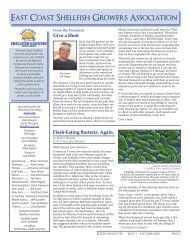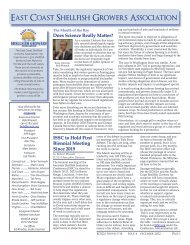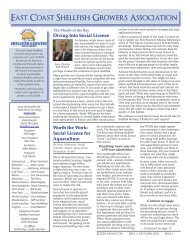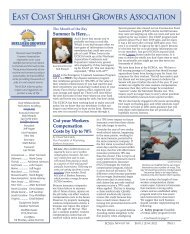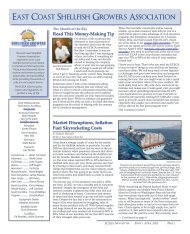East Coast Shellfish Growers Association August 2021 Newsletter
Read about the new disaster assistance for shellfish growers from the Farm Service Agency:ELAP; the death of Walt Canzonier; a win for South Carolina growers with help from allies; new biodegradable netting from Ketcham Supply; Prop 65 warnings; shellfish farm ecosystem services study.
Read about the new disaster assistance for shellfish growers from the Farm Service Agency:ELAP; the death of Walt Canzonier; a win for South Carolina growers with help from allies; new biodegradable netting from Ketcham Supply; Prop 65 warnings; shellfish farm ecosystem services study.
You also want an ePaper? Increase the reach of your titles
YUMPU automatically turns print PDFs into web optimized ePapers that Google loves.
— Continued from page 10
Pity the Resource Manager
Precious few individuals in our society would
willingly sacrifice anything they believe is theirs
for the benefit of the “greater good.”
How is the typical underpaid and overworked
state resource manager supposed to navigate
this minefield? I suppose the primary concern
is pleasing the bosses and keeping your job.
That means meeting all the various (often conflicting
and vague) legal mandates of dozens
of federal and state regulations. From there it
seems that the best approach is to try striking
an equitable balance among the many vested
resource users, while striving to meet the constitutional
mandate to maximize the benefit to
the sovereign. Perhaps the hardest part of the
job is tuning out the threats of the loudmouths
and blowhards, and the protests of the rich and
powerful.
When it comes to shellfish farming I find it
pretty easy to win over concerned individuals
when I talk about it in the abstract, especially
one on one. Few people can credibly object to
a policy that calls for allocating 5-10 percent of
a waterbody to the sustainable production of
seafood. In fact, objectors look pretty unreasonable
and selfish if their only complaint is that
they don’t want to look at us. Yet you can pretty
much take it to the bank that when a farm
is proposed in front of someone’s waterfront
home, mobs with pitchforks, torches, highly
paid lawyers and expert witnesses will come
out swinging. Allegations of environmental
harm will be leveled and claims of navigational
hazards will be put forward.
Unfortunately, all too often rational thought
and scientific evidence are set aside to accommodate
politics and the concerns of the rich
and powerful. Even if the applicant can show
that the proposed farm poses a minor inconvenience
to a small number of people, if those
people are well-connected they will often carry
the day. I take some solace in the knowledge
that lawsuits leveled against resource managers
typically fail. If permitting agencies follow the
state’s guiding documents and regulations, and
consider the various lines of evidence presented,
the agencies can usually defend themselves
on questions of how they manage public
resources.
On the other hand, I can point to too many
cases where the rich and powerful have defeated
the reasonable and rational. Applicants are
often put in the impossible position of proving
a negative, asked to show that their proposed
lease is not the best fishing spot in the state, or
their farm will not disturb the environment.
Resource managers often say they have struck
the proper balance when all sides are equally
pissed off, but all too often it seems they ignore
enabling language in state law noting that aquaculture
is in the public interest, and instead bow
to the pressure from the rich and powerful.
I wish I had some uplifting message or advice
for new growers wading into these perilous
waters. I often say that farming shellfish takes
an extraordinary combination of pigheadedness
and patience, and if you can’t tolerate the
application process then you probably won’t
last long as a farmer. The trial-by-fire that applicants
must endure will certainly temper your
steel, but may also take a toll on your sanity.
— Continued from page 5
Eliminating Risk
High-pressure processing will kill
most bacteria, but to eliminate
norovirus would require such
intense pressure that the shellfish
would be rendered unpalatable.
I think we can be proud of the
improvements we have made in
reducing the risk per serving associated
with the consumption of
raw shellfish. We have a complex,
multi-faceted regulatory process
that makes consumers confident
enough to continue to purchase
our products. We may rail against
restrictive regulations and aggressive
enforcement, but this is the
price we pay for robust consumer
demand. The risk of illness for
most foods is close to zero, but
defining the level of “acceptable
risk” for regulators and consumers
will always remain a challenge.
1. Zwietering et al., All food
processes have a residual risk,
some are small, some very small
and some are extremely small:
zero risk does not exist. Current
Opinion in Food Science,
June 2021. doi.org/10.1016/j.
cofs.2020.12.017
Page 12 ECSGA Newsletter Issue 3 August 2021




